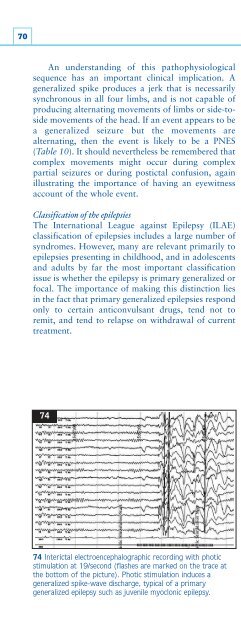You also want an ePaper? Increase the reach of your titles
YUMPU automatically turns print PDFs into web optimized ePapers that Google loves.
70An understanding of this pathophysiologicalsequence has an important clinical implication. Ageneralized spike produces a jerk that is necessarilysynchronous in all four limbs, and is not capable ofproducing alternating movements of limbs or side-tosidemovements of the head. If an event appears to bea generalized seizure but the movements arealternating, then the event is likely to be a PNES(Table 10). It should nevertheless be remembered thatcomplex movements might occur during complexpartial seizures or during postictal confusion, againillustrating the importance of having an eyewitnessaccount of the whole event.Classification of the epilepsiesThe International League against Epilepsy (ILAE)classification of epilepsies includes a large number ofsyndromes. However, many are relevant primarily toepilepsies presenting in childhood, and in adolescentsand adults by far the most important classificationissue is whether the epilepsy is primary generalized orfocal. The importance of making this distinction liesin the fact that primary generalized epilepsies respondonly to certain anticonvulsant drugs, tend not toremit, and tend to relapse on withdrawal of currenttreatment.Primary generalized epilepsies make up 10% ofadult epilepsies as a whole, but up to 50% ofepilepsies presenting in the late teens. The mostcommon phenotype is juvenile myoclonic epilepsy(JME). This presents with tonic–clonic convulsions incombination with myoclonic jerks, which usuallyoccur in the morning. Some patients have aphotoconvulsive response (74), which may manifestas a tendency to have seizures in response to flashesof certain frequencies. A minority of patients alsohave true petit mal absence seizures; these consist ofarrest of activity and loss of contact lasting severalseconds (75). In some patients, seizures occur in thecontext of sleep deprivation, or following alcoholexcess. Other phenotypes, such as early morningtonic–clonic seizures in adolescence, may beencountered. It is rare for primary generalizedepilepsies to present after the age of 25 years.AurasThe aura of a seizure is a subjective feeling that thepatient associates with the beginning of the seizure. Itis in fact the very beginning of the seizure, reflectingthe effects of the seizure discharge while it remainsvery localized, and therefore is usually a feature offocal or secondary generalized seizures. Auras are747574 Interictal electroencephalographic recording with photicstimulation at 19/second (flashes are marked on the trace atthe bottom of the picture). Photic stimulation induces ageneralized spike-wave discharge, typical of a primarygeneralized epilepsy such as juvenile myoclonic epilepsy.75 Electroencephalographic recording during a generalized'petit mal' seizure, showing generalized 3/second spike andwave discharges.
















